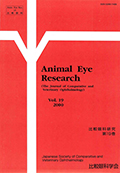Volume 19
Displaying 1-16 of 16 articles from this issue
- |<
- <
- 1
- >
- >|
Review
-
2000 Volume 19 Pages 1-9
Published: 2000
Released on J-STAGE: December 25, 2020
Download PDF (4376K)
Original Reports
-
2000 Volume 19 Pages 11-19
Published: 2000
Released on J-STAGE: December 25, 2020
Download PDF (4853K) -
2000 Volume 19 Pages 21-27
Published: 2000
Released on J-STAGE: December 25, 2020
Download PDF (3262K) -
2000 Volume 19 Pages 29-32
Published: 2000
Released on J-STAGE: December 25, 2020
Download PDF (1719K)
Case Report
-
2000 Volume 19 Pages 33-36
Published: 2000
Released on J-STAGE: December 25, 2020
Download PDF (1611K)
Proceedings - 1999 Annual Meeting
Special lecture
-
2000 Volume 19 Pages 37-42
Published: 2000
Released on J-STAGE: December 25, 2020
Download PDF (3234K)
Educational lecture
-
2000 Volume 19 Pages 43-47
Published: 2000
Released on J-STAGE: December 25, 2020
Download PDF (2754K) -
2000 Volume 19 Pages 49-52
Published: 2000
Released on J-STAGE: December 25, 2020
Download PDF (1775K)
Symposium : Canine Ophthalmology - Clinical Diagnosis and Theraphy
-
2000 Volume 19 Pages 53-57
Published: 2000
Released on J-STAGE: December 25, 2020
Download PDF (2011K) -
2000 Volume 19 Pages 59-63
Published: 2000
Released on J-STAGE: December 25, 2020
Download PDF (1885K)
Workshop : Cataract in Animals
-
2000 Volume 19 Pages 65-66
Published: 2000
Released on J-STAGE: December 25, 2020
Download PDF (677K) -
2000 Volume 19 Pages 67
Published: 2000
Released on J-STAGE: December 25, 2020
Download PDF (328K) -
2000 Volume 19 Pages 68-69
Published: 2000
Released on J-STAGE: December 25, 2020
Download PDF (594K) -
2000 Volume 19 Pages 70-71
Published: 2000
Released on J-STAGE: December 25, 2020
Download PDF (644K) -
2000 Volume 19 Pages 72-73
Published: 2000
Released on J-STAGE: December 25, 2020
Download PDF (644K)
Informations
-
2000 Volume 19 Pages 75-76
Published: 2000
Released on J-STAGE: December 25, 2020
Download PDF (896K)
- |<
- <
- 1
- >
- >|
